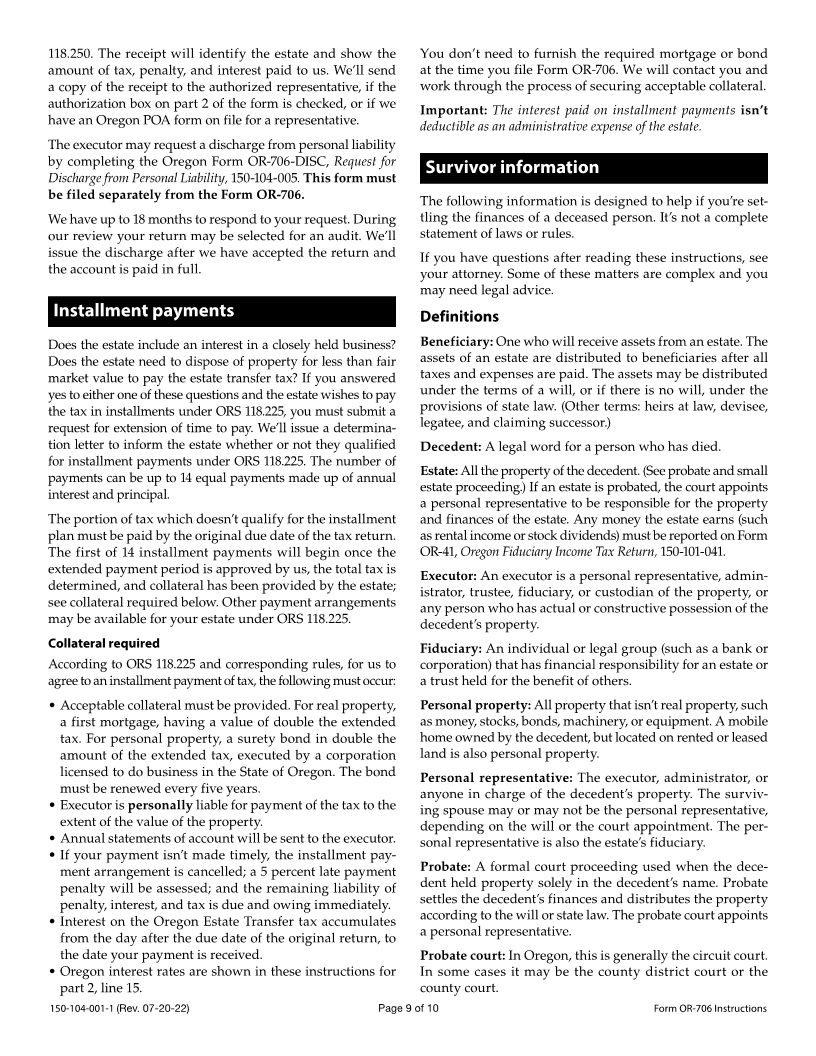
Enlarge image
Form OR-706 Instructions
Oregon Estate Transfer Tax 2022
This publication is a guide, not a complete statement, of Oregon Revised Statutes (ORS) and Oregon Administrative Rules (OAR).
For possible updates and more information, refer to the laws and rules on our website, www.oregon.gov/dor.
Contents
Purpose of Form OR-706 ......................................................2 Amount paid by the due date of the return ......................5
Penalty due .............................................................................5
What’s new ...............................................................................2 Interest due .............................................................................5
Total due .................................................................................6
Looking ahead ........................................................................2 Executor signature .................................................................6
Authorization .........................................................................6
Important .................................................................................2
Part 3: Elections by the executor .......................................6
Overview ...................................................................................2
Alternate valuation ................................................................6
Filing requirements ...............................................................2 Special use valuation of Section 2032A ..............................6
Who must file the return ......................................................2 Reversionary or remainder interests ..................................6
When to file return—due date ............................................3
Part 4: General information ................................................6
Mailing addresses and payment instructions ...............3 Surviving spouse ...................................................................6
Returns ....................................................................................3 Beneficiary information........................................................6
Payment only..........................................................................3 Section 2044 property ...........................................................7
Private delivery services .......................................................3 Insurance not included in the gross estate ........................7
Amended returns ..................................................................3 Partnership interests and stock in closely
Forms and schedules ............................................................3 held corporations ...................................................................7
Trusts .......................................................................................7
Part 1: Decedent and executor information ..................4
Decedent name and SSN ......................................................4 Part 5: Recapitulation ...........................................................7
Decedent domicile .................................................................4 Conservation easement exclusion .......................................7
Extensions ...............................................................................4 Deductions ..............................................................................7
Separate election checkbox ..................................................4 Marital deduction—Schedule M .........................................7
Executor name and address ................................................4
Part 6: Tax table ......................................................................8
Part 2: Tax computation ...................................................... 4 Assembly and processing.....................................................8
Rounding off to whole dollars ............................................ 4 Filing checklist for Form OR-706 .........................................8
Total gross estate ...................................................................4 What happens after you file the tax return? .....................8
Oregon estate tax. ..................................................................4
Installment payments ...........................................................9
Gross value of property located in Oregon .......................5
Oregon percentage ................................................................5 Survivor information ............................................................9
Tax payable to Oregon ..........................................................5
Definitions ..............................................................................9
Natural resource and commercial
fishing business credit ..........................................................5 Do you have questions or need help? ............................ 10
150-104-001-1 (Rev. 07-20-22) Page 1 of 10 Form OR-706 Instructions








